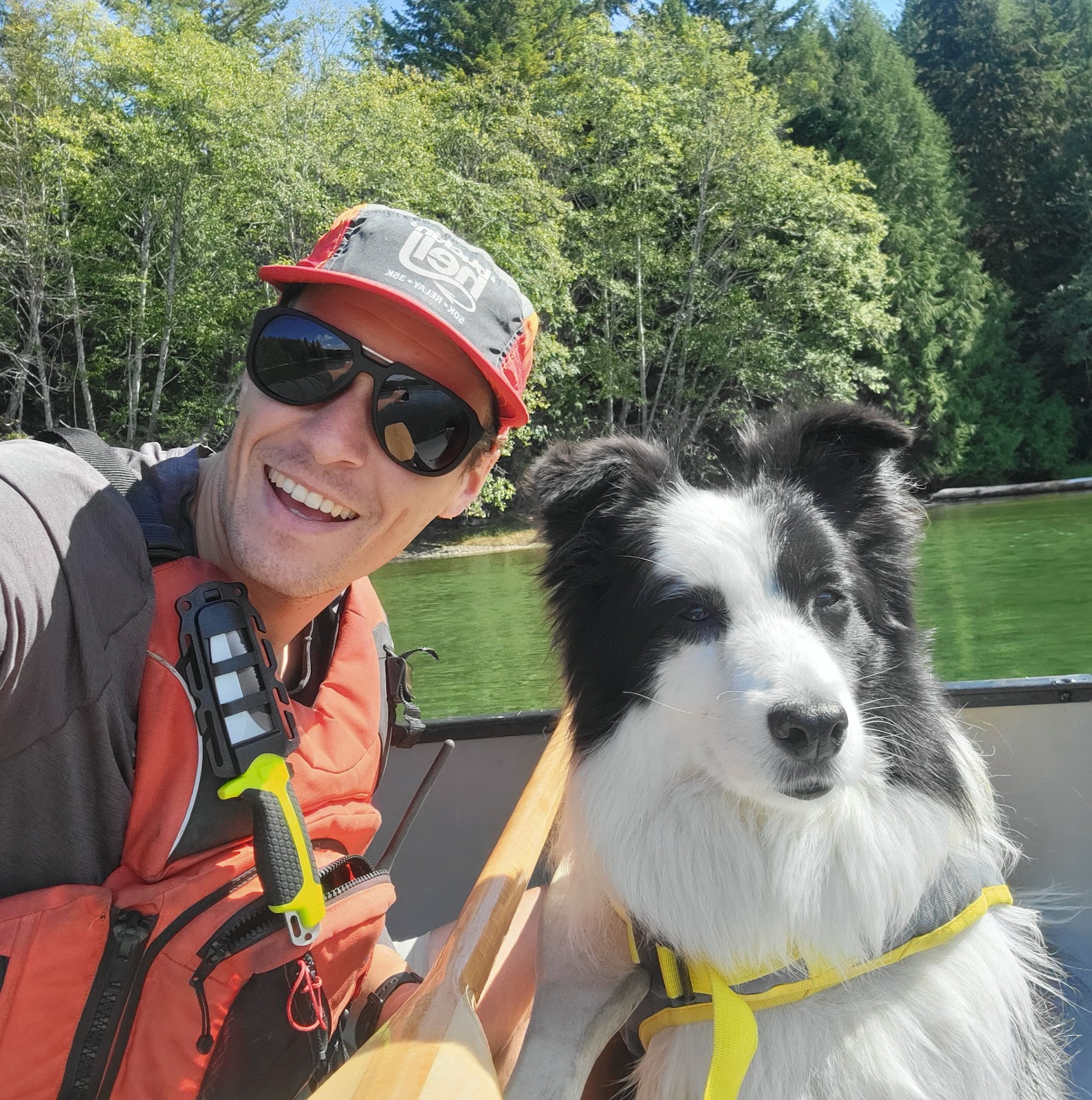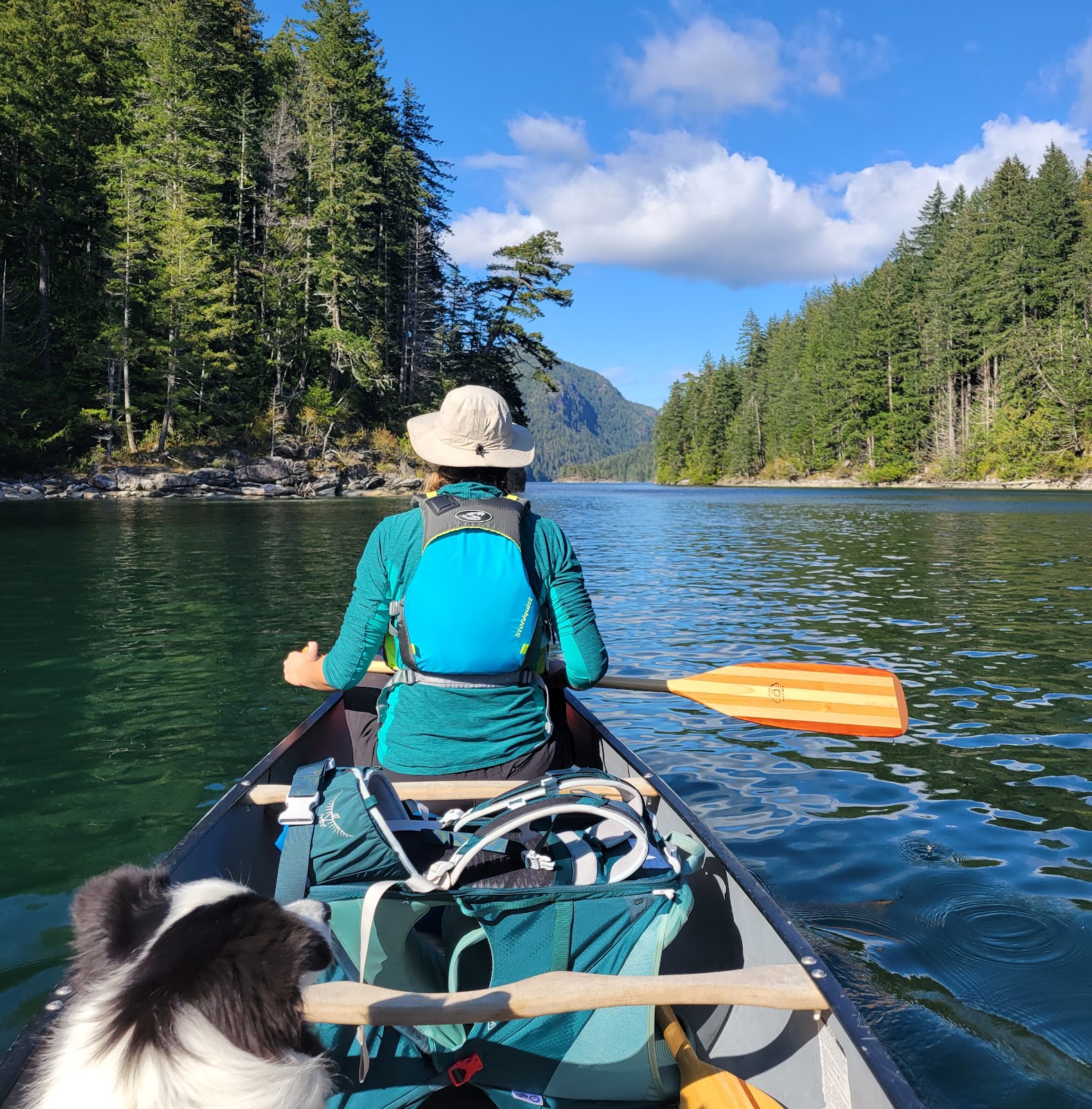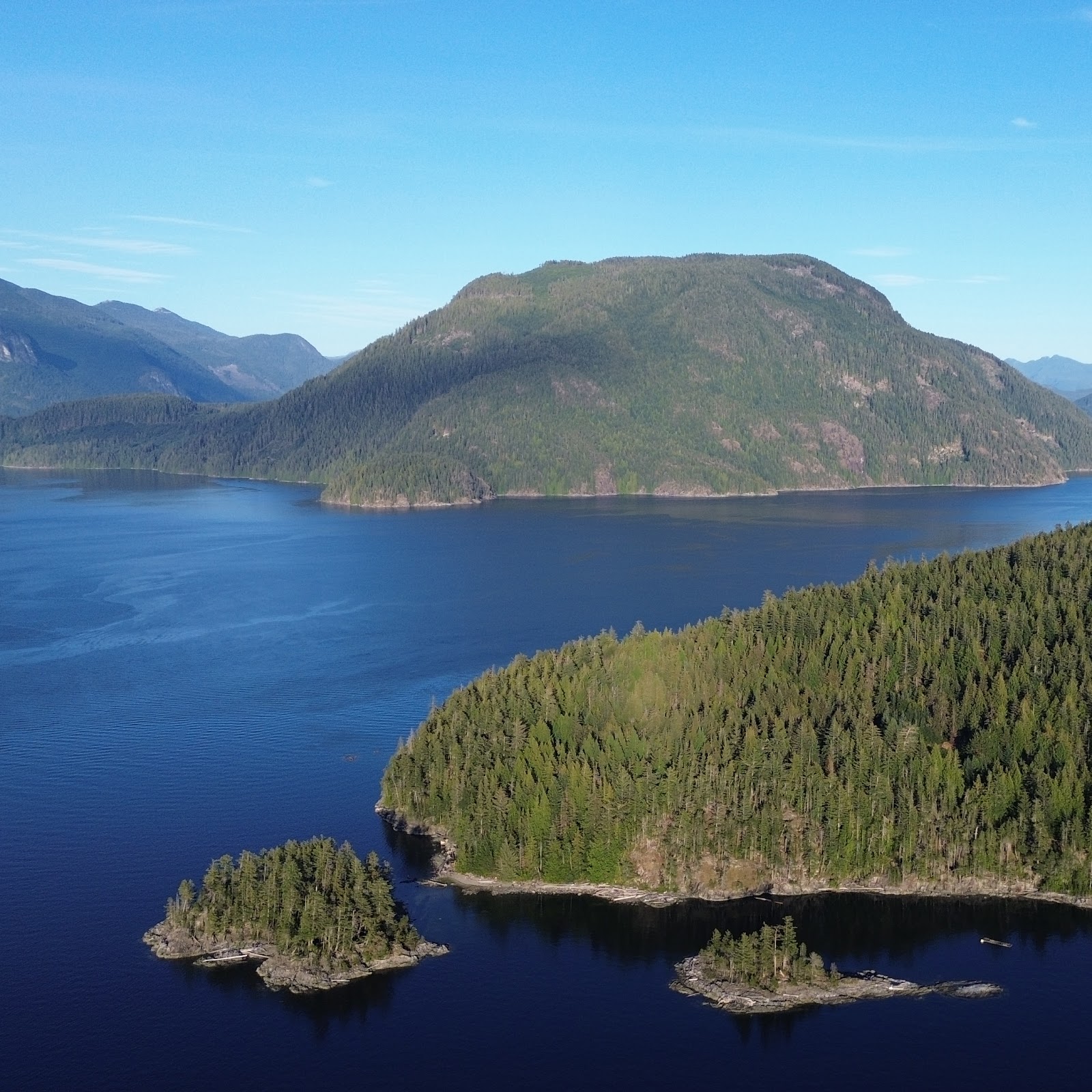Discovery Islands by Canoe
Circumnavigating Maurelle Island in British Columbia by Canoeing over 6 days / 55km. Including Surge Narrows, Octopus Islands, The Hole in the Wall and North Rendezvous Island with my wife Claire, daughter Alexandra and our dog Zoa.
Every summer for the past few years, we've done a big canoe trip where we paddle into the BC wilderness for a week or more. No Netflix, no social media, no distractions, just each other, a canoe and nature. We call these trips "Wayaways".
This year, I had been eyeing the Sayward Forest circuit, but the hot summer had left the rivers too dry to make that work in late August with a little one. So I turned my attention to the ocean and found myself drawn to the channels and islands north of Quadra Island. This is part of Discovery Islands, an area we'd never explored before.
 |
These trips require a lot of planning and research. The BC Marine Trails website is a great resource for finding camp spots and I saw lots of options suggesting a loop around Maurelle Island could be a good route. I wanted to keep the route short since this was our first Wayaway with Alexandra, only 10 months old. The loop would be around 55km total with only 2 camp sites and some rest days built in.
One landmark jumped out straight away. "Surge Narrows". The name sounded ominous and a quick search online found lots of pics and videos of kayakers surfing tidal rapids. Not something I fancied doing with a fully loaded canoe, including a 10-month-old and an anxious dog. Luckily I'd become very familiar with tide and current charts last year on our Broughton Archipelago trip so I could identify slack times where we could safely paddle through with no currents.
The plan was to start at Hoskyn Channel landing on Quadra Island and paddle NW through Surge Narrows to Octopus Islands Marine Provincial Park where we'd camp for three nights. Then paddle NE through "The Hole in the Wall" and loop around the North shore of Maurelle Island to reach North Rendezvous Island where we'd camp for another couple of nights. Finally, we'd paddle South through Whiterock Passage, past Surge Narrows and back to Hoskyn Channel Landing.
Day 1 (Aug 25) - Hoskyn Channel Landing to Octopus Islands - 11km
Slack in Surge Narrows wasn't until 15:40 so we spent the morning with friends in Campbell River before catching the ferry to Quadra Island and driving to Hoskyn Channel Landing. We were on the water by 15:00 and from there it's a short paddle to Surge Narrows. We timed the narrows perfectly and sailed through with a very slight current in our favor and not a whirlpool in sight. Alex screamed the whole way, and didn't stop until we got near camp. I'd identified a few camp spots and we stopped at a small forested island marked as "Octopus Islands" on BC Marine Trails. There's a sheltered cove to unload the canoe on the NW side, and a trail leading up to a few really good camp spots with pretty views. Luckily there was no one else in sight other than a few boats anchored in the nearby coves. A great spot to spend a few nights.
Day 2 (Aug 26) - The Storm
The forecast showed steady rain all day, getting heavier and windier by evening, then clearing up suddenly. I'd spent the night before "hunkering in", making sure the tent was secure, setting up a tarp so we could sit outside and cook, checking for dead tree branches. It was a very restful day with some breaks in the rain where we could stretch our legs. We made chili dogs for lunch and collected rain water for cooking so we weren't using up our fresh water supplies. We later found a running stream West of our island. As the day went on, the rain got heavier and the wind blew harder so we retreated into our tent. Then the storm really hit, and harder than I had anticipated. Sheets of rain started blasting against the side of the tent, causing me to prop the tent walls up out of fear of the poles snapping while Claire tried to calm Zoa and Alex. Huge puddles started to form under the tent. The wind kept lashing. Suddenly, we heard a loud crash which we assumed was a branch falling. When the storm eased we poked our heads out of the tent to see a large tree had fallen and landed a few meters away. We were both stunned! That tree seemed solid. I'd anchored the tarp to it.
Lesson learned - if you plan on camping through a storm, check every tree and every branch near your camp carefully to make sure they aren't dead.
Day 3 (Aug 27) - Exploring Octopus Islands ~ 5km
After the stress of the previous night, we fancied another restful day. It was sunny but still quite gusty. I went for a short paddle with Zoa to check for fresh water sources (as mentioned, there's a good stream in the bay to the West). This paddle turned out to be more stressful than I anticipated when the wind picked up suddenly, causing Zoa to freak out and almost capsize the canoe multiple times. Paddling into a strong headwind while trying to control the dog was impossible so I got pushed around a fair bit until I could drop her off on our island and paddle back around to the sheltered cove.
In the afternoon we all went for a paddle to explore a few more islands. Once again, the wind picked up and gave us quite a bumpy ride back to camp while Alex slept soundly in the front of the canoe.
A couple of kayakers had arrived to camp on the island. Really nice guys about our age so we joined them in the evening for beers, whisky and some great conversation.
Day 4 (Aug 28) - "The Hole in the Wall" to North Rendezvous Island - 15km
A day we'll not soon forget. The night before we'd worked out that best time to hit the next narrows was 13:20 at the turn of the current. I was basing that off the current charts for Surge Narrows (approx 12km away) since that was the closest I could find. I should have done a bit more research than that but the Government of Canada current station for "Hole in the Wall" is shut down.
We woke up to a calm, sunny morning and scurried to pack up camp and get on the water. We raced over to Francisco Island and as we paddled closer to the Hole in the Wall, we felt ourselves being pushed backwards by a strong current. For a few minutes we were barely making progress and this should have been the point we retreated but we thought our timing was correct. As soon as we broke through that current we started getting pulled into the channel by a more powerful current. I don't know what speed the water was moving, but it was moving! There were no rapids, but it felt like paddling in a convoluted river. The water on the North side of the channel looked calmer once through the mouth so we pushed as hard as we could to get across. I was calling to Claire at the bow of the canoe. "Draw, back paddle, pry, forward paddle". It was over quickly and somehow we both stayed calm despite genuinely being afraid for a few minutes! Alex slept through the whole thing, and luckily Zoa stayed calm.
Once through the "Hole in the Wall", the current eased and we sailed North East up the passage. I felt sick, quite disappointed in myself for my lack of preparedness that put us all at risk. I've since read that the turn at the "Hole in the Wall" could be 50 minutes before Surge Narrows, we were a bit earlier than planned meaning we were maybe 30-40 mins off slack. I'm now not convinced there's ever a time that the water is calm or not moving here, and you need to time this one perfectly!
I totally underestimated these narrows and how complex and unique the timing can be from place to place. Don't assume that one current chart will work for another spot that's only a few KM away. It can vary dramatically. The ocean taught me important lessons today.
Thankfully, the rest of the day was uneventful and we made good time getting to North Rendezvous Island where there's a beautiful campsite on a small islet at the Northern end - featuring a rope swing! At low tide the islet becomes connected to the main island via a "Tombolo", and at high tide there's shallow water perfect for swimming and paddling. We relaxed, reflected, found cell reception and regretfully watched a YouTube video of boats going through The Hole in the Wall rapids at max current, which scared us even more.
Day 5 (Aug 29) - Exploring North Rendezvous Island - 7km
After the challenges of the day before, we allowed ourselves a lazy morning and a relaxed paddle around North Rendezvous Island. The views in this area are stunning with a backdrop of the Coast Mountains with some large channels and bodies of water weaving in between. The weather was warm and sunny and luckily the fire ban lifted just in time for us to have a campfire on the beach which Alex helped me build, toddling around with sticks. It all came together to make a perfect final day with my family out in the Coastal wilderness.
Day 6 (Aug 30) - North Rendezvous Island to Hoskyn Channel Landing - 12km
Our final paddle involved paddling South down Whiterock Passage and through another narrows, this one quite shallow with a man-made channel for boats. I was worried this could turn out to be as tricky as the last one, but since we had cell reception I did some research and it seemed quite benign. The paddle down the passage was quite pleasant and we had a slight current in our favor as we traveled through the narrows. However, once through those narrows we would paddle right past Surge Narrows which we needed to time properly so those strong currents didn't impact us too much. We were early and headed close to see how strong the currents were. It became obvious quickly that we were too early so we retreated and took a longer way around to stay well clear of the "Surge" before crossing from the SeaPlane base to reach Hoskyn Channel Landing.
Final Thoughts
This trip was full of successes and failures, all of which were valuable learning experiences for future trips with my family.
The two biggest takeaways were:
1. When camping through a storm, we need to do a more thorough job of securing the site including checking for any dead trees, and even digging some irrigation channels so huge puddles don't form.
2. Any narrow passage in the ocean can produce wildly varying currents. Research each passage specifically, watch videos, ask around, and don't assume a current table from a nearby passage will apply.
Despite those 2 challenges, this was a really fun trip. I loved being able to share the wilderness with my 10-month-old daughter and see her interact with nature. She took it all in her stride and has become an expert napper in the front of the canoe - even through crazy currents.
The stressful times reminded me what a great teammate Claire is. When times get tough, she stays calm and level headed. And she's a really strong paddler!
This is a beautiful area, and the complexity of the travel makes it feel so much more wild. There's a lot more I'd like to do in the Discovery Islands... but I think we'll do a lake trip for the next one.




















Comments
Post a Comment